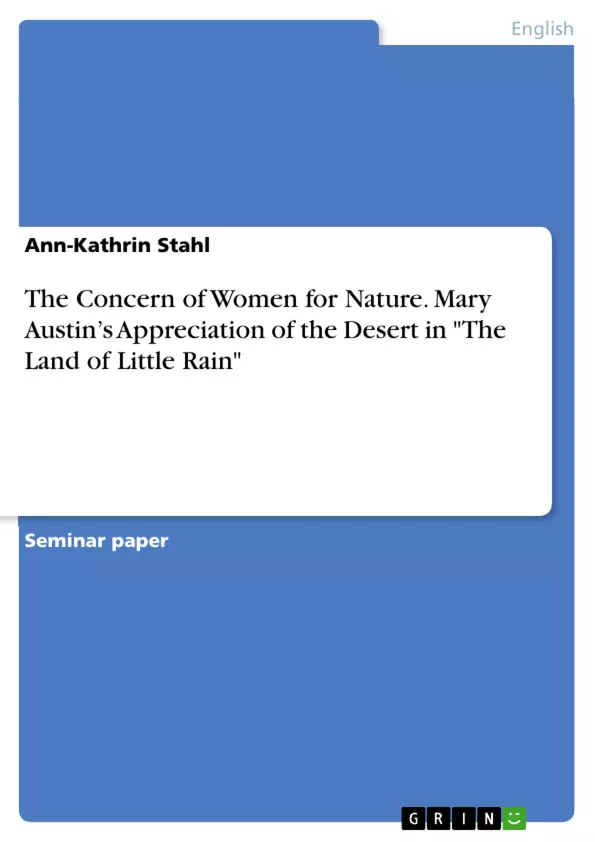“In response to the industrial revolution of the late 18th century” (Scheese 6) a new field of literary studies has been established. Derived from former pastoralism, authors now engage into what is called ‘nature writing’. Addressing the concerns of life in the country, attention is directed to the different forms of nature as well. One of these nature writers can be found in Mary Hunter Austin, an American writer who expresses her “affinity for nature, and more particularly the desert” (Scheese 76) by describing the landscape of the Mojave Desert in Southern California the way she perceived it during her walks through it.
Austin successfully creates a whole new picture of it in her work "The Land of Little Rain". Through her celebration of a land often perceived as sterile and uninteresting, Austin helped create in America what had not existed before the turn of the century: a desert aesthetic.
What Scheese here calls “a desert aesthetic” (Scheese 75) describes the establishment of a literary discourse exclusively centered around literature about the desert. Desert literature itself offers numerous possibilities for writers at the beginning of the twentieth century, especially for female writers as it “inspired cultural fantasies and enabled real and imagined experiences of solitude, comntemplative repose, divine revelation” (Gersdorf 16). As a consequence, the stories of female writers can be understood as symbolic since the action is moved from a former domestic space to the public sphere in form of the desert. This also conforms to the character of the concept of ‘New Womanhood’ which signifies a newly gained freedom for women at the end of the nineteenth century as their determination of staying within the domestic sphere was finally abandoned.
To prove this statement, the following essay initially gives a short overview of the literary study of nature writing and its more recent descendant, namely ‘desert literature’. Moreover, the second part of the essay will show how Mary Hunter Austin succeeds in transferring her appreciation of the desert into
her short story collection "The Land of Little Rain", where she attributes utopian qualities to the theme of the desert. The third part will finally analyze Austin’s novel with regard to her gender, her concern for nature and the developments concerning the ecofeminist movement at the beginning of the
twentieth century.
Inhaltsverzeichnis (Table of Contents)
- Introduction
- Nature Writing
- Desert Literature
- Definition of the Term "Desert"
- The Desert as a Critical Concept in Literature
- Austin's Appreciation of the Desert in The Land of Little Rain
- The Concern of Women for Nature
- Definition of Ecofeminism
- Traces of Ecofeminism in The Land of Little Rain
- Conclusion
Zielsetzung und Themenschwerpunkte (Objectives and Key Themes)
This essay aims to explore the significance of Mary Hunter Austin's The Land of Little Rain within the context of nature writing and desert literature. It will delve into Austin's appreciation of the desert landscape and how her work reflects the broader movement of ecofeminism in the early 20th century.
- The development and significance of nature writing as a literary genre.
- The unique characteristics and interpretations of desert literature.
- Mary Hunter Austin's depiction of the Mojave Desert and its significance in The Land of Little Rain.
- The exploration of ecofeminist themes and their connection to Austin's writing.
- The role of female writers in challenging traditional literary norms.
Zusammenfassung der Kapitel (Chapter Summaries)
The introductory chapter provides an overview of nature writing, tracing its origins to pastoralism and its emergence as a response to the industrial revolution. It highlights the shift from urban to rural landscapes as a central theme in nature writing.
The chapter on desert literature examines the definition of the term "desert" from both geographical and symbolic perspectives. It discusses the prevalent theme of "lack" in desert literature, encompassing the absence of water, vegetation, and animal life.
Focusing on Mary Hunter Austin's The Land of Little Rain, this chapter explores Austin's appreciation for the Mojave Desert. It delves into how her work challenges conventional perceptions of the desert as a barren wasteland, highlighting its unique beauty and ecological significance.
Schlüsselwörter (Keywords)
Nature writing, desert literature, Mary Hunter Austin, The Land of Little Rain, Mojave Desert, ecofeminism, New Womanhood, landscape, symbolism, literary discourse.
- Arbeit zitieren
- Ann-Kathrin Stahl (Autor:in), 2014, The Concern of Women for Nature. Mary Austin’s Appreciation of the Desert in "The Land of Little Rain", München, GRIN Verlag, https://www.grin.com/document/345387



